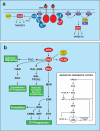Deregulation of cell signaling in cancer
- PMID: 24561200
- PMCID: PMC4111980
- DOI: 10.1016/j.febslet.2014.02.005
Deregulation of cell signaling in cancer
Abstract
Oncogenic mutations disrupt the regulatory circuits that govern cell function, enabling tumor cells to undergo de-regulated mitogenesis, to resist to pro-apoptotic insults, and to invade through tissue boundaries. Cancer cell biology has played a crucial role in elucidating the signaling mechanisms by which oncogenic mutations sustain these malignant behaviors and thereby in identifying rational targets for cancer drugs. The efficacy of such targeted therapies illustrate the power of a reductionist approach to the study of cancer.
Keywords: Cancer cell biology; Cell signaling; Targeted therapies; Tumorigenesis.
Copyright © 2014 Federation of European Biochemical Societies. Published by Elsevier B.V. All rights reserved.
Figures






References
Publication types
MeSH terms
Grants and funding
LinkOut - more resources
Full Text Sources
Other Literature Sources

